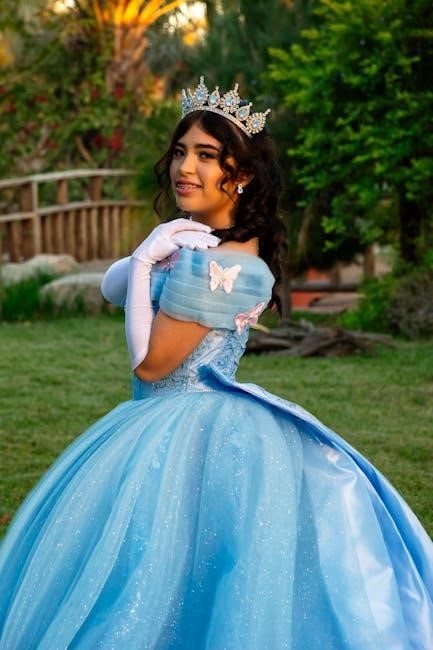
Seriously‚ Cinderella is So Annoying! offers a fresh feminist perspective on the classic tale‚ blending humor with social critique to challenge traditional gender roles and stereotypes effectively.
Overview of “Seriously‚ Cinderella is So Annoying!”
Seriously‚ Cinderella is So Annoying! is a modern‚ humorous retelling of the classic Cinderella story‚ offering a fresh perspective on the beloved fairy tale. Written by Trisha Speed Shaskan‚ this adaptation challenges traditional gender roles and stereotypes through satire and wit. The book explores Cinderella’s character in a way that highlights her agency and independence‚ departing from the passive heroine often depicted in traditional versions. With its lighthearted tone and contemporary twists‚ the story engages readers by poking fun at the annoyances of the original tale while maintaining its timeless charm. This adaptation has gained attention for its unique approach to storytelling and its ability to resonate with modern audiences seeking more dynamic female protagonists.
Background of the Book and Its Author
Trisha Speed Shaskan‚ the author of Seriously‚ Cinderella is So Annoying!‚ brings a unique voice to children’s literature with her humorous and satirical approach. This book is part of a series of modern Cinderella adaptations that challenge traditional narratives. Shaskan’s work often focuses on reimagining classic tales with a feminist lens‚ emphasizing female empowerment and critique of societal norms. The book has been praised for its ability to engage young readers while sparking critical thinking about gender roles. It is widely available in digital formats‚ including PDF‚ and has been featured on platforms like Epic!‚ a popular digital reading platform. Shaskan’s contributions to children’s literature highlight her commitment to creating stories that resonate with contemporary audiences.
Importance of Analyzing Modern Cinderella Adaptations

Analyzing modern Cinderella adaptations like Seriously‚ Cinderella is So Annoying! is crucial for understanding how classic tales evolve to reflect contemporary values. These adaptations often challenge traditional gender roles and societal expectations‚ offering fresh perspectives on familiar stories. By examining such works‚ readers can explore themes like feminism‚ humor‚ and personal growth‚ which are central to Shaskan’s narrative. This analysis also highlights how modern literature encourages critical thinking about classic fairy tales‚ making them relevant to new generations. Studying these adaptations provides insights into cultural shifts and the enduring appeal of Cinderella’s story‚ bridging the gap between tradition and innovation in children’s literature. This approach fosters a deeper appreciation for how stories adapt to resonate with modern audiences.

Plot Summary
Seriously‚ Cinderella is So Annoying! reimagines the classic tale with a modern twist‚ focusing on Cinderella’s frustrations with her stepsisters‚ stepmother‚ and the charming yet clueless prince.
The Original Cinderella Story
The classic Cinderella tale tells the story of a young girl mistreated by her stepmother and stepsisters after her father’s death. Despite her hardships‚ Cinderella remains kind and hopeful. With the help of her fairy godmother‚ she attends the prince’s ball‚ captivates him‚ and leaves behind a glass slipper. The prince searches for her‚ and upon finding Cinderella‚ marries her‚ securing her happily-ever-after. This timeless narrative explores themes of resilience‚ kindness‚ and transformation‚ making it a beloved story across generations. Its enduring appeal has inspired countless adaptations‚ including modern reinterpretations like Seriously‚ Cinderella is So Annoying!‚ which offer fresh perspectives on the classic tale.
Modern Twists in “Seriously‚ Cinderella is So Annoying!”
In Seriously‚ Cinderella is So Annoying!‚ the traditional Cinderella story is reimagined with bold humor and satire. The narrative shifts from Cinderella’s perspective to that of her stepsisters‚ offering a unique viewpoint that challenges the classic portrayal of villains. The book introduces a modern dialogue style‚ making the characters relatable to young readers. It also critiques the unrealistic expectations placed on Cinderella‚ highlighting her frustration with the pressures of her situation. By flipping the script‚ the story encourages readers to question traditional roles and empathize with characters often dismissed as antagonists. This fresh take transforms the fairy tale into a contemporary commentary on societal expectations and individual agency.
Key Differences from Traditional Cinderella Tales
Seriously‚ Cinderella is So Annoying! deviates from classic Cinderella stories by presenting a humorous and satirical narrative told from the perspective of Cinderella’s stepsisters. Unlike traditional tales‚ this adaptation humanizes the stepsisters‚ portraying them as multidimensional characters rather than one-dimensional villains. The book also critiques Cinderella’s passivity‚ highlighting her frustration with the unrealistic expectations placed upon her. Modern dialogue and relatable scenarios make the story fresh and engaging for contemporary readers. By flipping the narrative‚ the story challenges readers to reconsider their assumptions about the characters and their roles in the classic fairy tale. This unique approach encourages empathy and understanding for all characters‚ not just Cinderella.

Character Analysis
The book reimagines Cinderella as assertive and vocal‚ while her sisters and stepmother are portrayed with depth‚ challenging traditional villain roles in a fresh‚ modern light.
Cinderella: A Modern Perspective
In “Seriously‚ Cinderella is So Annoying!”‚ Cinderella is reimagined as a bold‚ assertive character who challenges the passive traits often associated with her traditional counterpart. This modern adaptation portrays Cinderella as vocal and independent‚ rejecting the classic trope of a damsel in distress. Her frustrations and annoyances with her circumstances are highlighted‚ making her relatable to contemporary readers. The book emphasizes her problem-solving skills and determination‚ shifting her role from a victim to an active participant in her own destiny. This reinterpretation encourages young readers to question gender stereotypes and embrace female empowerment‚ offering a fresh and inspiring take on the beloved fairy tale character.
The Role of the Evil Sisters and Step Mother
The evil sisters and stepmother in “Seriously‚ Cinderella is So Annoying!” are portrayed with exaggerated flaws‚ amplifying their comedic and antagonistic roles. Their relentless scheming and selfishness serve as a stark contrast to Cinderella’s resilience‚ highlighting her strength and moral integrity. The stepmother’s manipulative nature and the sisters’ spoiled behavior are central to the plot‚ driving much of the conflict and humor. Their exaggerated annoyance adds depth to the story‚ making them memorable and reinforcing the theme of female empowerment. This modern twist on the classic villains ensures they remain relevant and engaging for contemporary readers while maintaining the traditional fairy tale structure. Their roles are pivotal in shaping Cinderella’s journey and character development.
The Prince: A Changing Character in Adaptations
In “Seriously‚ Cinderella is So Annoying!”‚ the Prince evolves from a passive‚ one-dimensional character to a more dynamic and relatable figure. Unlike traditional adaptations‚ this Prince is portrayed with humor and a sense of agency‚ breaking free from the typical “rescuer” trope. His character is fleshed out‚ showing vulnerability and a modern perspective‚ which makes him more endearing to contemporary readers. The Prince’s role shifts from being merely a love interest to an active participant in Cinderella’s journey‚ reflecting evolving societal views on gender roles. This adaptation humanizes him‚ adding depth to the story and challenging traditional notions of masculinity in fairy tales. His transformation highlights the importance of mutual respect and partnership in relationships‚ making him a more engaging and memorable character in this modern retelling.
Themes and Messages
The book explores themes of feminism‚ self-discovery‚ and humor‚ challenging traditional fairy tale narratives while promoting empowerment and personal growth through Cinderella’s modern journey.
Feminism and Female Empowerment
Seriously‚ Cinderella is So Annoying! reimagines Cinderella as a strong‚ independent character‚ rejecting passive traits. The story emphasizes self-reliance and challenges patriarchal norms‚ encouraging readers to question traditional gender roles. Cinderella’s empowerment is highlighted through her agency and voice‚ breaking free from the damsel-in-distress trope. This modern twist inspires young readers to embrace their individuality and assertiveness‚ aligning with contemporary feminist values. The author uses humor to critique societal expectations‚ making the message accessible and engaging; By portraying Cinderella as a proactive figure‚ the book fosters a sense of female empowerment‚ urging girls to take control of their own narratives and futures;
Humor and Satire in the Story
The book’s humor and satire redefine Cinderella’s narrative‚ poking fun at traditional fairy tale tropes. Through witty dialogue and exaggerated characters‚ the story critiques societal norms‚ making it relatable and entertaining. The author uses irony and sarcasm to highlight the absurdity of certain expectations placed on women‚ such as the glass slipper’s impracticality or the fairy godmother’s over-the-top interventions. This humorous approach makes the story engaging for young readers while subtly delivering a message about questioning outdated beliefs. The blend of comedy and social commentary ensures the tale remains lighthearted yet thought-provoking‚ appealing to both children and adults alike‚ and making it a delightful read.
Self-Discovery and Personal Growth
Cinderella’s journey in this adaptation is not just about attending a ball but about self-discovery. The story emphasizes her growth from a passive character to someone who takes charge of her life. Through her experiences‚ she learns to value her own worth and challenges the notion of needing a prince for happiness. The narrative highlights her internal struggles and moments of realization‚ showing how she navigates societal expectations while staying true to herself. This focus on personal growth transforms her into a modern‚ empowered heroine. By prioritizing self-awareness and independence‚ the book offers a refreshing take on the classic tale‚ inspiring readers to embrace their own journeys of self-discovery.

Reception and Reviews
The book has sparked mixed reactions‚ with some praising its modern twist and humor‚ while others find Cinderella’s portrayal overly annoying and unconventional‚ dividing opinions sharply.
Public Reaction to the Book
The book has received mixed reactions from readers‚ with some appreciating its humorous and satirical take on the classic Cinderella story. Many readers have praised the modern twist and the way it challenges traditional gender roles‚ making it a fresh and engaging read. However‚ others have expressed frustration with Cinderella’s portrayal‚ finding her character overly annoying and unconventional compared to the original tale. The book’s ability to provoke strong emotions and spark discussions about gender stereotypes has made it a polarizing yet thought-provoking read. Its unique approach has resonated with younger audiences‚ encouraging them to think critically about fairy tale narratives and their relevance in contemporary society.
Critical Acclaim and Controversies
Seriously‚ Cinderella is So Annoying! has garnered both critical acclaim and controversy. Critics praise its bold reimagining of Cinderella‚ applauding its feminist themes and humorous satire. The book’s ability to challenge traditional narratives has been highlighted as a strength‚ making it a standout in modern fairy tale adaptations. However‚ some critics argue that the protagonist’s annoying traits overshadow her potential for growth‚ leading to mixed opinions on her character development. Additionally‚ the book’s unconventional approach has sparked debates among scholars about the balance between satire and storytelling. Despite these controversies‚ the book remains a significant work in the discourse on gender roles and fairy tale reinterpretations‚ fostering important conversations in literary circles.

Impact on Young Readers
Seriously‚ Cinderella is So Annoying! has made a notable impact on young readers‚ encouraging them to think critically about traditional narratives. The book’s relatable humor and modern twists resonate with children‚ making it accessible and engaging. By presenting Cinderella as flawed yet empowered‚ it challenges young readers to question gender stereotypes and embrace self-reliance. Some educators commend the book for sparking discussions on feminism and personal growth‚ while others highlight its ability to make classic tales relevant in contemporary contexts. Overall‚ the book’s influence lies in its capacity to inspire young readers to reflect on their own values and aspirations‚ fostering a deeper connection with the story’s themes and messages‚ and promoting a more nuanced understanding of character development and societal expectations.

Academic and Literary Analysis
The book sparks academic interest with its modern twists‚ offering insights into feminist themes and comedic storytelling‚ while its language and style invite comparative analysis with other adaptations.
Thesis Exploration of Cinderella Adaptations
The thesis delves into modern Cinderella retellings‚ focusing on how Seriously‚ Cinderella is So Annoying! reimagines the classic tale with a feminist twist. By analyzing its satirical tone‚ the book challenges traditional gender roles and societal expectations‚ offering a fresh perspective on Cinderella’s character. It explores how humor and irony are used to critique the original story’s flaws‚ such as Cinderella’s passivity and the lack of agency for female characters. The thesis also examines the book’s appeal to young readers‚ highlighting its ability to spark critical thinking about fairy tale narratives. Comparisons with other adaptations reveal how this version stands out in its bold‚ modern reinterpretation of a timeless story.
Use of Language and Style in the Book
The book Seriously‚ Cinderella is So Annoying! employs a satirical tone to critique traditional Cinderella narratives. Its language is sharp and ironic‚ using humor to highlight the absurdities of the original tale. The author’s style is conversational‚ making the story relatable and engaging for modern readers. By amplifying Cinderella’s frustrations‚ the text challenges the passive heroine trope‚ offering a more empowered female character. The narrative voice is bold and irreverent‚ encouraging readers to question societal expectations. This blend of wit and feminism creates a fresh‚ contemporary take on the classic fairy tale.
Comparative Analysis with Other Cinderella Versions
Seriously‚ Cinderella is So Annoying! stands out among Cinderella adaptations with its bold‚ satirical voice. Unlike traditional versions‚ this book flips the narrative‚ presenting Cinderella as exasperated with her circumstances‚ not passively enduring them. While classic tales often romanticize her suffering‚ this adaptation mocks such portrayals‚ offering a feminist critique. It also contrasts sharply with other modern retellings like Prince Cinders‚ which focus more on humor without the same level of social commentary. By making Cinderella an active‚ annoyed character‚ the book challenges the notion of female meekness‚ creating a unique and refreshing perspective that resonates with contemporary readers seeking empowered female protagonists.

Cultural and Social Implications
Seriously‚ Cinderella is So Annoying! challenges traditional narratives‚ empowering female characters and sparking cultural discussions on modern gender roles and contemporary societal expectations through humor and satire.

Representation of Annoying Traits in Fairy Tales
The book Seriously‚ Cinderella is So Annoying! reimagines Cinderella as a relatable‚ flawed character‚ highlighting her frustration with her circumstances and the people around her. By giving Cinderella a voice to express her annoyance‚ the story challenges the traditional portrayal of her as a passive‚ overly patient figure. This shift humanizes her‚ making her more accessible to modern readers. The narrative humorously critiques the unrealistic expectations placed on female characters in fairy tales‚ encouraging readers to question these tropes. This approach not only modernizes the classic tale but also sparks conversations about gender roles and societal norms‚ offering a fresh perspective on a beloved story.
Modern Annoyances in Traditional Stories
Seriously‚ Cinderella is So Annoying! introduces modern frustrations into the classic fairy tale‚ making Cinderella’s experiences relatable to contemporary readers. The book highlights her irritation with her stepfamily’s cruelty and the societal expectations placed upon her. By giving Cinderella a voice to express her annoyance‚ the story modernizes her character‚ showing her as a flawed yet resilient figure. This approach bridges the gap between traditional and modern storytelling‚ allowing readers to connect with her struggles on a deeper level. The narrative also uses humor to critique outdated gender roles‚ making the tale both entertaining and thought-provoking. This blend of modern annoyances and timeless themes creates a fresh perspective on a beloved classic.
Changing Perceptions of Cinderella’s Character
The book Seriously‚ Cinderella is So Annoying! challenges traditional portrayals of Cinderella by presenting her as a relatable‚ modern character with frustrations and flaws. Unlike the passive heroine of classic tales‚ this Cinderella openly expresses her annoyance at her stepfamily and societal expectations‚ making her more human and accessible to contemporary readers. By giving her a voice to vent her irritations‚ the story redefines her character‚ shifting from a one-dimensional figure to a dynamic‚ empowered individual. This reinterpretation encourages readers to see Cinderella as a strong‚ independent woman rather than a victim of circumstance‚ fostering a more feminist and progressive understanding of her role in the narrative.

Seriously‚ Cinderella is So Annoying! reimagines the classic tale with humor and modern critique‚ offering fresh insights into Cinderella’s character and encouraging readers to think critically about traditional narratives while embracing feminist values.
Final Thoughts on the Book’s Significance
Seriously‚ Cinderella is So Annoying! stands out as a bold reimagining of the classic fairy tale‚ offering a fresh feminist perspective that challenges traditional narratives. By blending humor with social critique‚ the book encourages readers to rethink Cinderella’s character and the societal expectations placed on women. Its ability to balance satire with heartfelt moments makes it a compelling read for both children and adults. The book’s significance lies in its capacity to spark critical thinking about gender roles and stereotypes‚ while also celebrating individuality and self-discovery. As a modern adaptation‚ it proves that fairy tales can evolve to resonate with contemporary audiences‚ making it a valuable addition to the genre of Cinderella retellings.
Future of Cinderella Adaptations
The future of Cinderella adaptations lies in bold‚ innovative retellings that challenge traditional narratives. Books like Seriously‚ Cinderella is So Annoying! pave the way for more diverse and critical interpretations‚ encouraging authors to explore unconventional perspectives. As society evolves‚ these adaptations will likely focus on themes of feminism‚ self-discovery‚ and social justice‚ resonating with modern audiences. The use of humor and satire‚ as seen in this book‚ may become a hallmark of future adaptations‚ making fairy tales more accessible and thought-provoking. By reimagining Cinderella’s story in fresh ways‚ these works will continue to captivate readers of all ages‚ ensuring the timeless tale remains relevant for generations to come.
Encouraging Critical Thinking in Fairy Tale Interpretations
Seriously‚ Cinderella is So Annoying! challenges readers to rethink traditional fairy tale narratives by presenting Cinderella as a flawed yet relatable character. This adaptation encourages critical thinking by questioning the passivity often associated with Cinderella‚ portraying her instead as an active participant in her destiny. The book’s satirical tone prompts readers to analyze the motivations of all characters‚ including the prince and the evil sisters‚ fostering a deeper understanding of their roles. By subverting expectations‚ it inspires readers to evaluate the broader societal messages embedded in fairy tales. This approach not only entertains but also educates‚ promoting a more nuanced interpretation of classic stories and their relevance in modern contexts.